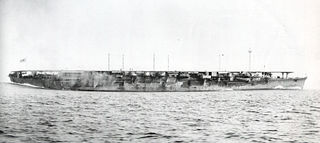- Japanese aircraft carrier Chiyoda
-

Career (Japan) 
Name: Chiyoda Operator: Imperial Japanese Navy Laid down: 26 November 1934 as seaplane carrier Launched: 29 November 1936 Commissioned: 25 July 1938 Recommissioned: 21 December 1943 Reclassified: 21 December 1943 as light carrier Refit: 1942 to 1944 Fate: Sunk 25 October 1944 General characteristics Class and type: Chitose-class aircraft carrier Displacement: 11,200 tons (standard)
15,300 tons (max.)Length: 192.5 m (632 ft) Beam: 20.8 m (68 ft) Draught: 7.5 m (25 ft) Propulsion: 2 geared turbines
2 steam turbines
2 shafts
56,800 shpSpeed: 28.9 knots Complement: 800 Armament: 8 x 127 mm
30-48 (in 1944) x 25 mmAircraft carried: 30 Chiyoda (千代田) was an Chitose class aircraft carrier of the Imperial Japanese Navy. She was originally built as a seaplane carrier, before being converted to a light carrier from March to December 1943.[1] She was damaged in the Battle of the Philippine Sea. She was sunk with all hands at the Battle of Cape Engano during the Battle of Leyte Gulf on 25 October 1944. After being crippled by four bombs dropped by aircraft from the carriers USS Franklin and Lexington, she was finished off by gunfire from the cruisers USS Santa Fe, Mobile, Wichita and New Orleans[2] along with nine destroyers, all under the command of Rear Admiral Laurence T DuBose.[1][3] Chiyoda was the largest vessel of any nationality which is definitely known to have been sunk with all hands during World War II.
References
- ^ a b "IJN Chiyoda: Tabular Record of Movement". http://www.combinedfleet.com/Chiyoda.htm. Retrieved 26 August 2008.
- ^ The Leyte Operation
- ^ Morison, Samuel Eliot (2007). The Two-Ocean War: A Short History of the United States Navy in the Second World War. Naval Institute Press, p. 465. ISBN 1591145244
Chitose · Chiyoda
Categories:- Chitose class aircraft carriers
- Ships built in Japan
- 1936 ships
- World War II aircraft carriers of Japan
- Ships damaged by aircraft
- World War II shipwrecks in the Philippine Sea
Wikimedia Foundation. 2010.
